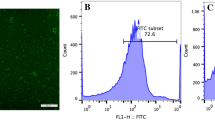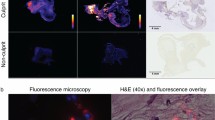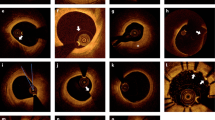Abstract
Neovascularization of the arterial walls by adventitial vasa vasorum appears to participate in the process of atherosclerosis progression and destabilization. Although the biological mechanisms associated with plaque instability are still unclear, the uncontrolled formation of intraplaque neovessels appears to contribute to the development of complex atheromatous lesions. Recent reports have described the use of several ultrasound-based techniques for the real-time detection of intraplaque neovascularization. Preliminary studies in animal models have shown that the detection and characterization of adventitial neovascularization are technically feasible. The further development of these imaging techniques relies on the successful implementation of contrast microspheres capable of enhancing microvascular structures. These contrast agents serve as surrogate red blood cells and perform acoustically as true intravascular tracers providing, in real-time, the amount and distribution of neovessels within atherosclerotic lesions. Several ultrasound-based techniques are under development for the detection of adventitial vasa vasorum in the carotid and coronary vascular territories. Although still in early validation phases, these techniques might permit the early diagnosis and stratification of subclinical atherosclerosis, thus permitting aggressive preventive therapy. In the near future, innovative contrast agents using specific ligands are likely to expand the diagnostic and therapeutic possibilities of these emerging imaging techniques.
Key Points
-
Atherosclerotic plaque neovascularization is thought to be key in the process of atherosclerosis progression and destabilization
-
Several ultrasound-based techniques are under development for the detection of atherosclerosis neovascularization in the carotid and coronary territories
-
Preliminary studies in animal models have shown that the detection and characterization of atherosclerotic plaque neovascularization are technically feasible
-
The development of these imaging techniques relies on the further development of contrast microsphere technologies capable of enhancing microvascular structures
-
In the future, ultrasound-based imaging techniques may permit the early diagnosis and stratification of subclinical atherosclerosis, thus permitting aggressive preventive therapy
This is a preview of subscription content, access via your institution
Access options
Subscribe to this journal
Receive 12 print issues and online access
$209.00 per year
only $17.42 per issue
Buy this article
- Purchase on Springer Link
- Instant access to full article PDF
Prices may be subject to local taxes which are calculated during checkout





Similar content being viewed by others
References
Gossl M et al. (2003) Impact of coronary vasa vasorum functional structure on coronary vessel wall perfusion distribution. Am J Physiol Heart Circ Physiol 285: H2019–H2026
Gossl M et al. (2003) Functional anatomy and hemodynamic characteristics of vasa vasorum in the walls of porcine coronary arteries. Anat Rec A Discov Mol Cell Evol Biol 272: 526–537
Clarke JA (1966) An x-ray microscopic study of the postnatal development of the vasa vasorum of normal human coronary arteries. Acta Anat (Basel) 64: 506–516
Clarke JA (1966) An x-ray microscopic study of the development of the vasa vasorum in the human foetal aorta and pulmonary trunk. Acta Anat (Basel) 63: 55–70
Schoenenberger F and Mueller A (1960) On the vascularization of the bovine aortic wall [German]. Helv Physiol Pharmacol Acta 18: 136–150
Gossl M et al. (2004) Vasa vasorum growth in the coronary arteries of newborn pigs. Anat Embryol (Berl) 208: 351–357
Wolinsky H and Glagov S (1967) Nature of species differences in the medial distribution of aortic vasa vasorum in mammals. Circ Res 20: 409–421
Barger AC et al. (1984) Hypothesis: vasa vasorum and neovascularization of human coronary arteries. A possible role in the pathophysiology of atherosclerosis. N Engl J Med 310: 175–177
Kumamoto M et al. (1995) Intimal neovascularization in human coronary atherosclerosis: its origin and pathophysiological significance. Hum Pathol 26: 450–456
Zhang Y et al. (1993) Immunohistochemical study of intimal microvessels in coronary atherosclerosis. Am J Pathol 143: 164–172
Kolodgie FD et al. (2003) Intraplaque hemorrhage and progression of coronary atheroma. N Engl J Med 349: 2316–2325
Virmani R et al. (2005) Atherosclerotic plaque progression and vulnerability to rupture: angiogenesis as a source of intraplaque hemorrhage. Arterioscler Thromb Vasc Biol 25: 2054–2061
Moreno PR et al. (2006) Neovascularization in human atherosclerosis. Circulation 113: 2245–2252
Koster W (1876) Endarteritis and arteritis. Berl Klin Wschr 13: 454–455
Martin JF et al. (1990) Arterial wall hypoxia following hyperfusion through the vasa vasorum is an initial lesion in atherosclerosis. Eur J Clin Invest 20: 588–592
Barger AC and Beeuwkes R III (1990) Rupture of coronary vasa vasorum as a trigger of acute myocardial infarction. Am J Cardiol 66: 41G–43G
Isner JM (1999) Cancer and atherosclerosis: the broad mandate of angiogenesis. Circulation 99: 1653–1655
Bayer IM et al. (2002) Experimental angiogenesis of arterial vasa vasorum. Cell Tiss Res 307: 303–313
Chen YX et al. (1999) Immunohistochemical expression of vascular endothelial growth factor/vascular permeability factor in atherosclerotic intimas of human coronary arteries. Arterioscler Thromb Vasc Biol 19: 131–139
Ignatescu MC et al. (1999) Expression of the angiogenic protein, platelet-derived endothelial cell growth factor, in coronary atherosclerotic plaques: in vivo correlation of lesional microvessel density and constrictive vascular remodeling. Arterioscler Thromb Vasc Biol 19: 2340–2347
Galili O et al. (2004) Adventitial vasa vasorum heterogeneity among different vascular beds. J Vasc Surg 40: 529–535
Galili O et al. (2005) Experimental hypercholesterolemia differentially affects adventitial vasa vasorum and vessel structure of the left internal thoracic and coronary arteries. J Thorac Cardiovasc Surg 129: 767–772
Herrmann J et al. (2001) Coronary vasa vasorum neovascularization precedes epicardial endothelial dysfunction in experimental hypercholesterolemia. Cardiovasc Res 51: 762–766
Fleiner M et al. (2004) Arterial neovascularization and inflammation in vulnerable patients: early and late signs of symptomatic atherosclerosis. Circulation 110: 2843–2850
Burke AP et al. (2001) Healed plaque ruptures and sudden coronary death: evidence that subclinical rupture has a role in plaque progression. Circulation 103: 934–940
Yeagle PL (1985) Cholesterol and the cell membrane. Biochim Biophys Acta 822: 267–287
Feinstein SB (2004) The powerful microbubble: from bench to bedside, from intravascular indicator to therapeutic delivery system, and beyond. Am J Physiol Heart Circ Physiol 287: H450–H457
Wei K et al. (1998) Quantification of myocardial blood flow with ultrasound-induced destruction of microbubbles administered as a constant venous infusion. Circulation 97: 473–483
Shaw LJ et al. for the Optison Multicenter Study Group (1998) Use of an intravenous contrast agent (Optison) to enhance echocardiography: efficacy and cost implications. Am J Manag Care 4 (Special issue): SP169–SP176
Mulvagh SL et al. (2000) Contrast echocardiography: current and future applications. J Am Soc Echocardiogr 13: 331–342
Montauban van Swijndregt AD et al. (1996) An in-vitro evaluation of the line pattern of the near and far walls of carotid arteries using B-mode ultrasound. Ultrasound Med Biol 22: 1007–1015
Wong M et al. (1993) Ultrasound-pathological comparison of the human arterial wall. Arterioscler Thromb 13: 482–486
Macioch JE et al. (2004) Effect of contrast enhancement on measurement of carotid artery intimal medial thickness. Vasc Med 9: 7–12
Feinstein SB (2006) Contrast ultrasound imaging of the carotid artery vasa vasorum and atherosclerotic plaque neovascularization. J Am Coll Cardiol 48: 236–243
Shah F et al. (2007) Contrast-enhanced ultrasound imaging of atherosclerotic carotid plaque neovascularization: a new surrogate marker of atherosclerosis? Vasc Med 12: 291–297
Carlier S et al. (2005) Vasa vasorum imaging: a new window to the clinical detection of vulnerable atherosclerotic plaques. Curr Atheroscler Rep 7: 164–169
Vavuranakis M et al. (2007) Detection of perivascular blood flow in vivo by contrast-enhanced intracoronary ultrasonography and image analysis: an animal study. Clin Exp Pharmacol Physiol 34: 1319–1323
Vavuranakis M et al. A new method for assessment of plaque vulnerability based on vasa vasorum imaging: by using contrast-enhanced intravascular ultrasound and differential image analysis. Int J Cardiol, in press
Goertz DE et al. (2006) Contrast harmonic intravascular ultrasound: a feasibility study for vasa vasorum imaging. Invest Radiol 41: 631–638
Goertz DE et al. (2007) Subharmonic contrast intravascular ultrasound for vasa vasorum imaging. Ultrasound Med Biol 33: 1859–1872
Acknowledgements
The authors wish to acknowledge W Li, T Thomas, TJ Teo (Boston Scientific Corporation, MA) and I Kakadiaris (University of Houston, TX) for editorial comments included in this manuscript.
Author information
Authors and Affiliations
Corresponding author
Ethics declarations
Competing interests
SB Feinstein has received speakers' honoraria and grant/research support from Takeda Pharmaceutical Company. JF Granada declared no competing interests.
Rights and permissions
About this article
Cite this article
Granada, J., Feinstein, S. Imaging of the vasa vasorum. Nat Rev Cardiol 5 (Suppl 2), S18–S25 (2008). https://doi.org/10.1038/ncpcardio1157
Received:
Accepted:
Issue Date:
DOI: https://doi.org/10.1038/ncpcardio1157
This article is cited by
-
Vasa vasorum of the failed aorto-coronary venous grafts
Surgical and Radiologic Anatomy (2018)
-
Contrast-enhanced ultrasound of the carotid system: a review of the current literature
Journal of Ultrasound (2017)
-
Evaluation of the stability of carotid atherosclerotic plaque with contrast-enhanced ultrasound
Journal of Medical Ultrasonics (2016)
-
SPECT/CT Imaging of High-Risk Atherosclerotic Plaques using Integrin-Binding RGD Dimer Peptides
Scientific Reports (2015)
-
A Review on Carotid Ultrasound Atherosclerotic Tissue Characterization and Stroke Risk Stratification in Machine Learning Framework
Current Atherosclerosis Reports (2015)



